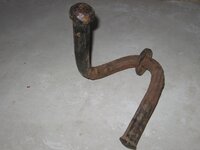wreckwriter
Jr. Member
Directly seaward of the Sunrise water tower, in about 60-65 feet of water, lies the wreck of the yacht Monomy. The Monomy is pretty much a flat wreck, just a big debris field, but is, at least was, covered with copper coated bronze shipbuilding pins, bronze/brass valves, and assorted other cool goodies. I haven't been there since the early 80s but it wasn't well known then and is likely forgotten by now. At the time there were no restrictions on recovering items in this area. PLEASE CHECK LOCAL LAWS BEFORE DIVING TO ENSURE THIS REMAINS ACCURATE.
Here's a few of the pins I recovered back then. There were literally thousands of these things, in all sizes, just laying on the bottom; my guess is there still are. The wreck has no historical significance and is really of interest to nobody. Local lore says she was a sailboat, approx 80 feet in length that burned. Charred wood on the site seems to confirm her fate. I don't have GPS coordinates, GPS didn't exist back then. Your best bet for finding her would probably be depth sounder searches (look for 5-10 feet of relief) or a snorkeler drag on a day with good water visibility. She's just past the reef line in sand.

Here's a few of the pins I recovered back then. There were literally thousands of these things, in all sizes, just laying on the bottom; my guess is there still are. The wreck has no historical significance and is really of interest to nobody. Local lore says she was a sailboat, approx 80 feet in length that burned. Charred wood on the site seems to confirm her fate. I don't have GPS coordinates, GPS didn't exist back then. Your best bet for finding her would probably be depth sounder searches (look for 5-10 feet of relief) or a snorkeler drag on a day with good water visibility. She's just past the reef line in sand.






